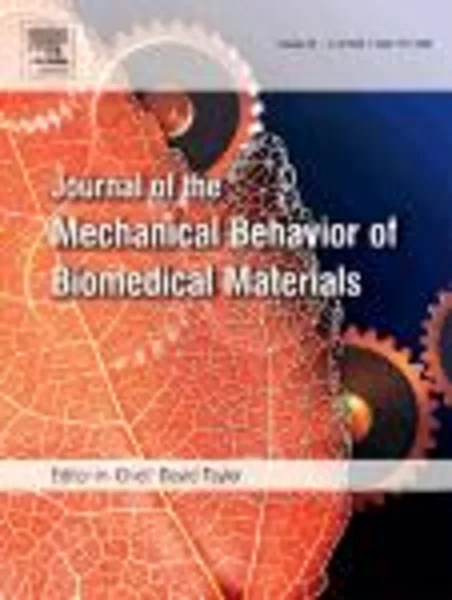-
the effect of different implant macrogeometries and surface treatment in early biomechanical fixation: an experimental study in dogs
جزئیات بیشتر مقاله- تاریخ ارائه: 1394/01/01
- تاریخ انتشار در تی پی بین: 1394/01/01
- تعداد بازدید: 792
- تعداد پرسش و پاسخ ها: 0
- شماره تماس دبیرخانه رویداد: -
implant surface characterization and biomechanical testing were made to evaluate the effect of different surface treatments along with different implant bulk configurations expressed as biomechanical fixation at early implantation times. three implant surfaces, namely bioactive ceramic electrodeposition (ed), alumina-blasted/acid etched (ab/ae), and resorbable blasting media (rbm) were fabricated in three implant macrogeometries (cylindrical, small chamber, and large chamber). all combinations between surface and bulk configurations were placed in the radii of beagle dogs (n = 18), which were euthanized 14 and 40 days after surgery (n = 9 animals per time in vivo). the implants were subjected to torque to interface fracture. effects of time, surface, and macrogeometry on torque to interface fracture were evaluated by a glm at 95% level of significance. the results showed a significant increase in torque as time elapsed in vivo (p < 0.001), and that the ed surface presented significantly higher values compared to ab/ae and rbm (p < 0.001) at both times. the small chamber only presented a significantly higher biomechanical fixation compared to other geometries at 40 days in vivo (p = 0.02). biomechanical fixation at 14 and 40 days was affected by implant surface treatment, whereas implant design only affected results at 40 days in vivo.
مقالات جدیدترین رویدادها
-
استفاده از تحلیل اهمیت-عملکرد در ارائه الگوی مدیریت خلاقیت سازمانی و ارائه راهکار جهت بهبود
-
بررسی تاثیر ارزش وجوه نقد مازاد بر ساختار سرمایه شرکت های پذیرفته شده در بورس اوراق بهادار تهران
-
بررسی تأثیر سطح افشای ریسک بر قرارداد بدهی شرکت های پذیرفته شده در بورس اوراق بهادار تهران
-
بررسی تأثیر رتبه بندی اعتباری مبتنی بر مدل امتیاز بازار نوظهور بر نقد شوندگی سهام با تأکید بر خصوصی سازی شرکت ها
-
تأثیر آمیخته بازاریابی پوشاک ایرانی بر تصویر ذهنی مشتری پوشاک ایرانی (هاکوپیان)
-
بازاریابی حسی: رویکرد نوین در صنعت بازاریابی
-
using jointly distributed random variables method to determination of saturated sand liquefaction reliability
-
ارائه مدل شبیه سازی برای بهینه سازی گردش مدارک کنترل پروژه
-
میوفیبروبلاستومای عقده لنفاوی در بازوی پسر بچه 13 ساله ”گزارش یک مورد“
-
برآورد بارمالی حوادث منجر به فوت در پروژه های ساختمانی شهر تهران در سال آتی
مقالات جدیدترین ژورنال ها
-
مدیریت و بررسی افسردگی دانش آموزان دختر مقطع متوسطه دوم در دروان کرونا در شهرستان دزفول
-
مدیریت و بررسی خرد سیاسی در اندیشه ی فردوسی در ادب ایران
-
واکاوی و مدیریت توصیفی قلمدان(جاکلیدی)ضریح در موزه آستان قدس رضوی
-
بررسی تاثیر خلاقیت، دانش و انگیزه کارکنان بر پیشنهادات نوآورانه کارکنان ( مورد مطالعه: هتل های 3 و 4 ستاره استان کرمان)
-
بررسی تاثیر کیفیت سیستم های اطلاعاتی بر تصمیم گیری موفق در شرکتهای تولیدی استان اصفهان (مورد مطالعه: مدیران شرکتهای تولیدی استان اصفهان)
-
تحلیل حکم حکومتی در فقه سیاسی
-
پنهان کاری در انتقال داده های پزشکی ایمن برای سیستم های مراقبت بهداشتی مبتنی بر iot
-
ارتباط کوته بینی مدیران با نوسانات سود و سهامداران عمده در شرکت های پذیرفته شده در بورس اوراق بهادار تهران
-
ارائه الگوی مدیریت استعداد در نهاجا
-
utilization of palm oil fuel ash and eggshell powder as partial cement replacement - a review




سوال خود را در مورد این مقاله مطرح نمایید :